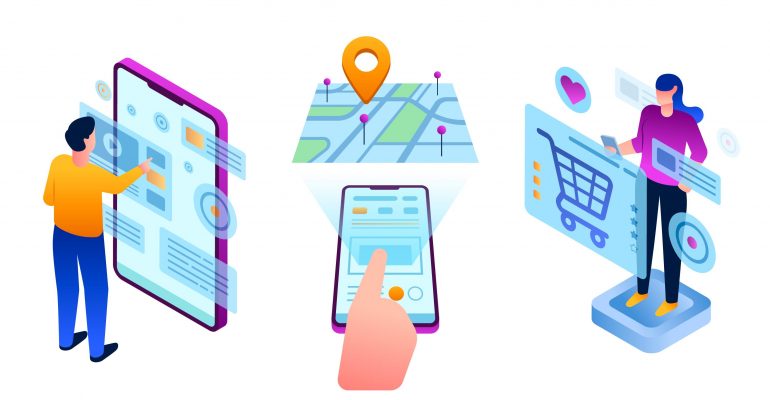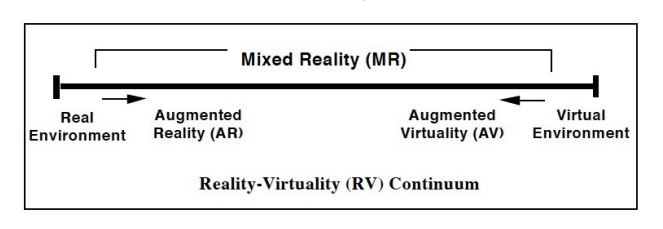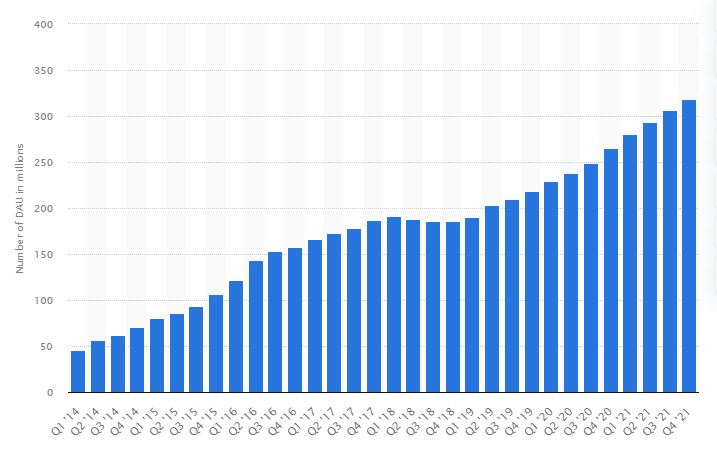
The importance of AR regarding mobile applications
Von Theresa Neurauter am 30.05.2022
Abstract
Augmented reality is a technology that enriches the real-world environment with virtual objects as well as audio or video. Due to the massive progress in the field of AR this technology gets more and more important for mobile applications. AR mobile applications are used in many different areas of life such as education or entertainment. In this article the importance of AR regarding mobile applications is discussed and examples for such applications are described.
1. Introduction
This article focuses on Augmented Reality and its use with mobile applications. Hence, the article deals with a definition of AR and the growing importance of this technology. Furthermore, various areas in which AR is already used are explained and illustrated with small examples. This article should show the opportunities and future directions as well as the intention to use AR applications in different areas of life.
Fast change of mobile devices has evolved technologies that are available at any time and any place. Augmented reality (AR) is one of these emerging technologies that has had a strong impact in recent years on different areas of life for example social media or education (Katsaros & Keramopoulos, 2017). The technology is considered the next big breakthrough. It inspires the minds of engineers and tech experts to think big and break the boundaries of established technologies. Compared to other reality technologies, AR stands between the virtual and the real world. The technology is gradually gaining popularity as elements like audio, video or other useful information interact within the real world, and therefore provide the user with an immersive experience („Augmented Reality und die Zukunft von Sozialen Medien Apps“, 2021).
2. Augmented Reality
2.1 Definition of AR
Described in a broad way, AR can be defined as “ a real world context that is dynamically overlaid with coherent location or context sensitive virtual information” (Klopfer & Squire, 2008). This means Augmented Reality is a technology that helps placing virtual objects into the real world. This allows people to see more, hear more or even touch more than one normally could (Katsaros & Keramopoulos, 2017). There are three main characteristics of AR, which are the combination of virtual and real objects in a real environment, taking place in real time and the alignment of virtual and real objects.
According to Milgram Augmented Reality is part of the Mixed reality as shown in Figure 1. Unlike Augmented Virtuality and Virtual environment where the environment is virtual, AR is defined as the environment being real and interacting with virtual and real objects (Azuma et al., 2001).

source: https://www.researchgate.net/figure/Milgram-and-Kishinos-Mixed-Reality-on-the-Reality-Virtuality-Continuum-Milgram-and_fig1_321405854
The beginning of Augmented Reality was already in the 1990’s, when it was mostly used to train pilots or for medical education. Since then, a lot of conferences regarding AR took place and over the past decade it has developed into a popular research field. Due to the fact that the technological progress of the last years has improved the performance of the hardware enormously, AR applications are used more widely. In addition, the use of GPS, cameras, gyroscopes, and other sensors in smartphones also promotes this trend. Furthermore, mobile devices are already available at lower prices, which also contributes to the increased use of Augmented Reality for mobile applications (Akçayır et al., 2016).
2.2 Examples of AR mobile applications
Unlike virtual reality apps that require powerful devices or even more than one tool to operate with, using augmented reality apps only requires a mobile device. Therefore, AR applications already have place in our daily lives. Below some examples are further discussed. AR brought a new dimension to pedagogical approaches in Teaching and Learning.
2.2.1 Education
AR takes place in education regarding different areas such as classroom teaching, learning strategies or Curriculum Design. Studies show that integrating AR into teaching strategies enhances enthusiasm, excitement, and entertainment towards the students. The use of this technology also helps to improve creativity, interaction, student-centric learning, and collaborative learning (Sunil & Kumaran Nair, 2017). Especially subjects that are more difficult to learn for some students can be better prepared through AR and thus be understood more easily. Math, science, engineering, or history are just a few examples. Another field is electronics since students often have problems understanding electricity (Álvarez-Marín et al., 2020).
2.2.2 Social Media
Augmented reality (AR) is one of the aspiring technologies that has had a strong impact on social media in recent years. According to the latest figures, almost 3 billion people use social media networks. Therefore, many social media platforms try to involve new technologies such as AR to become even more popular. Snapchat for example is exploiting this opportunity by making it even easier to share creative pictures with your friends. The company integrated different AR features like touch, facial expression, and movements into the app for more variety. Due to this, the experience users go through while using the app rose and made the platform even more popular. As shown in Figure 2 the number of Snapchat user is raising and one of the reasons for this is the steady implementation of AR features („Augmented Reality und die Zukunft von Sozialen Medien Apps“, 2021).

Augmented Reality effects for social media have become one of the most popular ways to add creativity to one’s content and stand out from the crowd. For example, the French artist Ines Longevial used a social media platform and designed a face filter that read „save the planet“ to draw attention to the climate crisis („Augmented Reality und die Zukunft von Sozialen Medien Apps“, 2021).
2.2.3 Agriculture
As frequently mentioned in this article, AR offers new opportunities in many areas especially in the interactions between humans and machines. Another area is agriculture where the development of modern agricultural technology and AR can help specialize the use of modern agricultural inputs or improve farm management.
The study by Katsaros & Keramopoulos shows that AR applications for mobile devices can be used to help farmers remember insects, diseases, and specific information about certain crops, among other things. By using this app, they can thus work more efficiently (Katsaros & Keramopoulos, 2017).
2.2.4 Other Industries
Other areas where AR applications are currently used include fields like medicin, military, entertainment games, tourism, shopping, and exhibitions. Since AR technology became that important in many areas of life the research regarding this technology is indispensable (Wang et al., 2021).
3 Opportunities and future intention to use AR
The technology of AR implements a new way of human-computer interaction and therefore enhances the user experience as well as the interactivity and the attraction of mobile products. AR helps to present things in a new way and puts them in a different perspective.
The world’s rapid change regarding technology will drive the emergence to more mobile development and AR applications in the future. The focus will lay even more on user interface design and visual design which implements attention on developing display technology, tracking technology, image integration technology and many more. Through this user will go through an immersive experience which will promote a positive view people have on the digital world. Additionally, it can be said that the rapid change of mobile devices also enhances the upcoming importance of AR technology. The screen quality is getting better and the overall interaction with such devices will continuously increase (Wang et al., 2021). Furthermore, as shown in Figure 3, the use of mobile devices has increased in recent years and is expected to continue to do so in the upcoming years (Turner, 2018).

4 Discussion and Conclusion
The findings of this article demonstrate the importance of the progress of AR technology in relation to mobile applications. It clearly shows that this digital transformation where virtual objects interact with the real environment opens up new perspectives in various fields such as education, medicine or entertainment. This brings rapid progress in many different areas of life. Another positive effect of AR technology is the engagement it brings with users which supports for example creativity and interaction. As pointed out in the examples described in this article, implementing AR in mobile applications increases the user experience and helps to increase the number of users. It can be said that the proliferation of this technology will continue to increase in the future and therefore offer opportunities to expand the experience of technology for different areas of life.
Future research with the focus on the importance of AR regarding mobile applications could delve further into the technological possibilities that AR offers. Since there is a rapid progress of technological change every year, the usage of AR will become more present, even in areas with currently less AR research.
References
Augmented Reality und die Zukunft von Sozialen Medien Apps. (2021, Februar 15). Abgerufen 26. April 2022, von https://de.yeeply.com/blog/augmented-reality-zukunft-der-sozialen-netzwerke/
Akçayır, M., Akçayır, G., Pektaş, H. M., & Ocak, M. A. (2016). Augmented reality in science laboratories: The effects of augmented reality on university students’ laboratory skills and attitudes toward science laboratories. Computers in Human Behavior, 57, 334–342. https://doi.org/10.1016/j.chb.2015.12.054
Álvarez-Marín, A., Velázquez-Iturbide, J. Á., & Castillo-Vergara, M. (2020). Intention to use an interactive AR app for engineering education. 2020 IEEE International Symposium on Mixed and Augmented Reality Adjunct (ISMAR-Adjunct), 70–73. https://doi.org/10.1109/ISMAR-Adjunct51615.2020.00033
Azuma, R., Baillot, Y., Behringer, R., Feiner, S., Julier, S., & MacIntyre, B. (2001). Recent advances in augmented reality. IEEE Computer Graphics and Applications, 21(6), 34–47. https://doi.org/10.1109/38.963459
Figure 1: Milgram and Kishino’s Mixed Reality on the Reality-Virtuality… (2017). ResearchGate. Abgerufen 26. April 2022, von https://www.researchgate.net/figure/Milgram-and-Kishinos-Mixed-Reality-on-the-Reality-Virtuality-Continuum-Milgram-and_fig1_321405854
Katsaros, A., & Keramopoulos, E. (2017). FarmAR, a farmer’s augmented reality application based on semantic web. 2017 South Eastern European Design Automation, Computer Engineering, Computer Networks and Social Media Conference (SEEDA-CECNSM), 1–6. https://doi.org/10.23919/SEEDA-CECNSM.2017.8088230
Klopfer, E., & Squire, K. (2008). Environmental Detectives—The development of an augmented reality platform for environmental simulations. Educational Technology Research and Development, 56(2), 203–228. https://doi.org/10.1007/s11423-007-9037-6
Sunil, S., & Kumaran Nair, S. S. (2017). An Educational Augmented Reality App To Facilitate Learning Experience. 2017 International Conference on Computer and Applications (ICCA), 279–282. https://doi.org/10.1109/COMAPP.2017.8079771
Turner, A. (2018, Juli 10). How Many People Have Smartphones Worldwide (Apr 2022). Abgerufen 27. April 2022, von https://www.bankmycell.com/blog/how-many-phones-are-in-the-world
Wang, Y., Wang, Y., & Fan, Z. (2021). Current Status and Prospects of Mobile AR Applications. 2021 International Conference on Culture-oriented Science Technology (ICCST), 34–37. https://doi.org/10.1109/ICCST53801.2021.00018
List of figures
Figure 1. Milgran and Kishino’s Mixes Reality on the Reality-Virtuality Continuum
Figure 2. Number of daily active Snapchat users from 1st quarter 2014 to 4th quarter 2021
Figure 3. Number of Smartphone & Mobile Phone Users Worldwide(Billions)

The comments are closed.